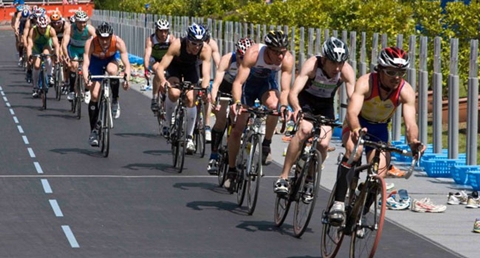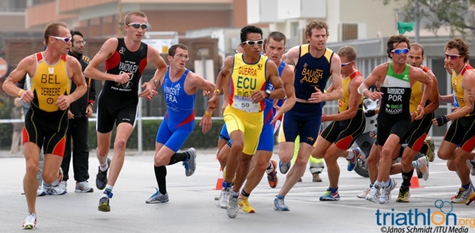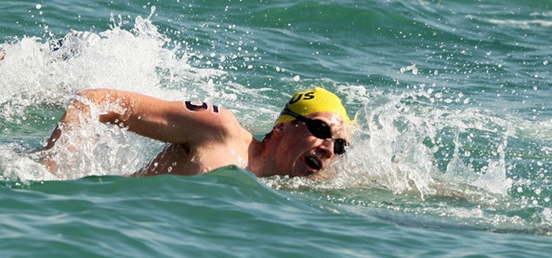Yoga Enhances Fitness and Improves Athletic Performance with Increased Mental Focus and Awareness
Yoga offers many benefits in a variety of domains for healthy, clinical, and, more recently, athletic populations. Athletes often undertake yoga as a complement to their training, to help enhance certain aspects of fitness as well as to increase mental focus and awareness.
The February 2010 issue of Yoga Journal features an article on Yoga of Champions (Anderson, Ferreira, and Ferretti, 2010). The opening statement: “From prerace jitters to finish-line focus, yoga is a training tool of choice for athletes competing in the 2010 Vancouver Olympics” speaks to the psychological benefits to be gained from yoga in the arena of elite level competition. Three Olympic athletes interviewed cite Yoga as an effective means of improving focus, concentration, and mental clarity; increasing awareness of breath, and feeling more calm and grounded.
In addition yoga offers a way of maintaining and improving fitness while doing rehab for an injury, that it serves as a complementary and restorative form of exercise in combination with or contrast to training sessions of high intensity that tend to drain energy, and providing an effective mode of stretching to increase flexibility and improve performance. In addition, yoga practice helps to improve posture, balance, strength, and flexibility along with kinesthetic awareness and core stability, all of which are critical to good performance in sports, whether you are a novice or an Olympic competitor and to good function in general.
Yoga can also play a key role in improving overall health (see Physiological, Cognitive and Psychological Benefits of Yoga) and a significant role in improved reducing stress and stress management (see Yoga: An Antidote to Stress).
Yoga will Improve Form, Efficiency and Power
In The Athlete's Guide to Yoga: An Integrated Approach to Strength, Flexibility, and Focus, by Sage Roundtree, it is affirmed Yoga yoga will make you a better athlete. It will help “improve your form, efficiency, and power”. “Yoga’s approach to concentration and breath awareness will improve your mental focus and mental endurance – the intangibles that become so important at the end of a long training session or race”. Furthermore, Rountree states that the physical practice of yoga combined with its mental and spiritual approach “will teach you how to integrate the body, the mind, and the breath to stay focused and calm even in the face of intensity – a skill that will serve you in every aspect of your life, be it training, racing, work, relationships, or undergoing a root canal”.
Customize Yoga to Specific Sports
Customized and more specific applications of yoga can be beneficial in running, golf, cycling, swimming and other sports. For example, Runners often have tight hamstrings due to the nature of the activity and from not stretching sufficiently. With its inclusion of forward folding or hip flexion and spinal forward flexion (examples in English nomenclature include Forward Fold, Seated Forward Fold, and Downward Facing Dog), yoga practice can improve hip extensor (hamstrings and glutes) and low-back (erector spinae) flexibility, along with hip flexor (quadriceps, iliopsoas) and calf (gastrocnemius and soleus) flexibility.
Ice hockey players who tend to have tight groin or hip adductor muscles might benefit from Lying Bound Angle pose or Happy Baby or Straddle Forward Bend. For golfers, baseball and tennis players, whose swing power depends on core strength and twisting or rotation of the hips, spine, and shoulder girdle, yoga helps develop muscular strength and endurance in the core with poses like Plank, Side Plank, and Warrior I, II, and III.
Yoga can assist in developing greater comfort, increased range of motion and endurance in twisting poses such as Spinal Twists variations, Twisting Chair, Twisting Lunge, Bound Angle, and Revolved Triangle. Yoga also focuses on proper alignment (e.g., head, neck, spine) and enhances core stability and balance through balance challenges and postures in multiple planes and positions (upright, seated, inverted, supine, prostrate), increased muscular strength and endurance, proprioception, kinesthetic awareness, and creating dynamic tension by contracting certain muscle groups. One example of all of these is Balancing Half Moon, a challenging, intermediate-level pose which involves alignment of the body in the sagittal plane, while balancing on one leg and lifting the other leg parallel to the floor, and twisting the body to open the hips and shoulders.
Be as disciplined with incorporating Yoga into your athletic training schedule as you are with your other strength, core, flexibility and balance training. Consider it part of your training!
Christina A. Geithner, Ph.D., FACSM, ACSM H/FS is a Professor in the Department of Human Physiology at Gonzaga University. She is a Fellow of the American College of Sports Medicine (ACSM), a certified ACSM Health/Fitness Instructor®, and a Registered Yoga Teacher (RYT-200). Tina was a member of the U.S. Diving, Inc. Talent Identification Committee (1991-2004) and has been involved in data collection and analysis relating to talent identification and profiling of elite athletes in women's ice hockey at the University of Alberta since 1999 with colleague Michael Bracko, Director, Institute for Hockey Research. She has designed and facilitated team building and leadership courses for graduate students in business, accounting, and organizational leadership; and has designed and facilitated team building and strategic planning programs for corporate and educational organizations. Tina has a B.S. in Health, Physical Education and Recreation from West Chester State College, specializing in Recreational Outdoor Pursuits Education; an M.A. in Physical Education from the University of Maryland; and a Ph.D. in Kinesiology from the University of Texas at Austin. Email Tina at: geithner@gonzaga.edu






